 John Booth © 26 March 2015
John Booth © 26 March 2015
Download this essay as a pdf here
It’s all to do with scale.
Now unequivocally immersed in the Milky Way, and getting close to Earth, we spot two quite large land masses straddling ten degrees of temperate waters half way between the Equator and the great southern white. The northernmost thrusts boldly up into the subtropics, whereas to the south of the lower one lies a scatter of tiny islands hanging on in the face of the Furious Fifties. Occasionally icebergs are visible.
And in the northeast of the North Island is a bay of many islets.
Bay of Islands lies within the giant Northeastern Biogeographic Coastal Region which extends all the way from Ahipara at the south end of Ninety Mile Beach on the west coast, around the top of the country (but skipping the Three Kings Islands), and sweeps south to the eastern-most spot on mainland New Zealand. Although its nearshore waters tend to be less turbid than those further south, we can’t categorically distinguish this region from space because its borders are concocted—it’s more that the combinations of plants and animals and non-living features of these shores and their waters to 200-metres depth have more in common within-region than beyond it.
The Bay of Islands is, however, an indisputable feature, cradled within the topography of the land. It’s here our journey enters the realm of an astonishing variety of creatures occupying all manner of seafloor types—and who inhale seawater. This diversity is all the more startling because much of it is—unlike the plants and animals on land—unfamiliar to us. Yet these marine species live by the same rules as we air-breathers, requiring oxygenation of cells, digestion of food for energy and nutrition, and elimination of waste.
A habitat map of the seafloor is no more than a crude representation of this diversity, its palette of colours representing different types of bottom with their associated plants and animals that make up the living communities. This rug-of-many-colours has expansive shades representing dominant seafloor types (soft bottom, rocky reef, and so on), and little stitches of other hue here and there to signify those less ubiquitous, such as rock pinnacles and seagrass meadows.
Although brimming with complexity, this is nevertheless very much a first-cut of the diversity of the sealife of the Bay of Islands. One of the few places to have been mapped at a scale of metres—rather than the more-usual tens or hundreds of metres—is an area off the southeast end of Urupukapuka Island. Here there are no fewer than eight distinct habitat types, each with its own myriad of life-forms. One of these is rocky reef, yet overturn a rogue boulder on that reef and you are confronted with yet another layer of life, one at home in dark recesses otherwise rare on this reef.
And accompanying each sponge and tube worm living under this rock are numerous other life forms; it’s just that they’re fast disappearing beyond our ability to see without a pince-nez.
It’s been all to do with scale.
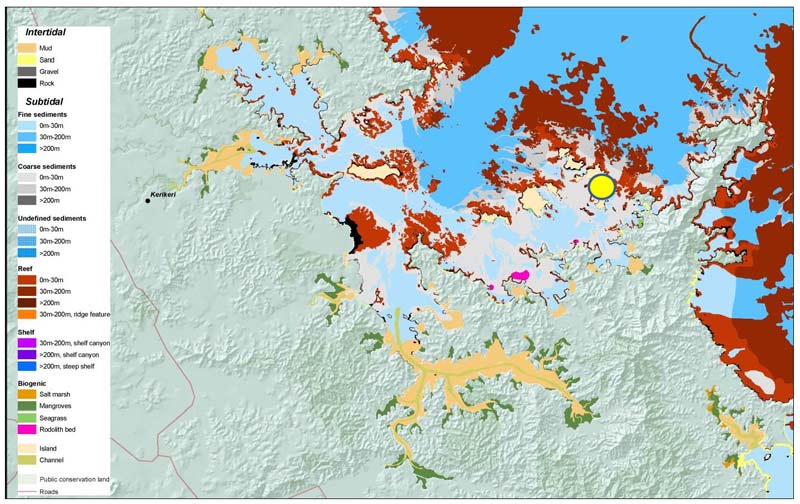
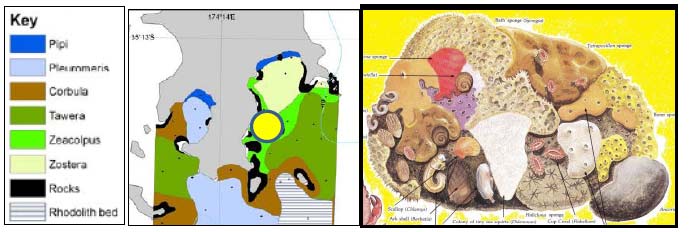
Substrate type—from the intertidal mud of estuaries to deep rocky reefs—is surrogate for the Bay of Islands’ plant and animal habitats and communities.1 But drill down and yet further layers of life are revealed. 2,3
$$$$$$$$$$$$$
The marine life of the Bay of Islands can be classified for convenience into ‘ecosystems’. An ecosystem is a particular combination of interacting living and non-living elements, as small and ephemeral as a shallow pooling of seawater high on a rocky platform after a violent easterly, or as expansive and permanent as an ocean. But marine ecologists typically cut their losses by talking about ones long-lived (years) and existing at scales of at least hundreds of square metres.
Many of Bay of Islands’ marine ecosystems are widespread, being also found at similar scale in other parts of the country. But others are rare, some not found anywhere else on the planet in its particular form. And what makes the Bay of Islands priceless is its rich variety of ecosystems. Within the two bold capes, the Bay of Islands is home to everything from mangroves to marlin. For example, well over 500 types of mollusc and 100 or so coastal fishes live here,4,5 and there are 200 species of large seaweeds within the Bay and nearby.6
Take the eastern part. In this one really-quite-small area you can paddle your waka in a couple of hours (10 minutes in the tinnie) from an estuary bordered by centuries-old mangrove trees, out onto the grounds of the big mommas. You glide past shores sheltered from the elements, their faces adorned with often-fragile life-forms, to those which from time to time face swells emerging from an entire ocean-width, the metres of plantless slope above the sea surface, and the temerity of the hangers-on below, demonstrating the point. You traverse estuarine waters containing so little salt that you could drink it—out to ones you’d swear grew crystals. Waters as murky as a mud-wallow to those simply transparent. Dark places, and light. Swirling currents, and then perfect tranquillity. Rocky reef to mudflat—and everything between, each with its special community of incumbents. And that’s before you even take the plunge.
Ecologists have wrestled to bring order to such diversity. The recent driver has been the New Zealand Biodiversity Strategy of 20007, reflecting New Zealand’s commitment, together with 200 others, in ratifying the International Convention on Biological Diversity agreed on in Rio de Janeiro in 1992, to help stem the global tide of species loss and ecosystem destruction. The convention recognises that biological diversity is not just about plants, animals and micro-organisms and their ecosystems; it’s also about people and our need for food security, medicines, fresh air and water, shelter, and a clean and healthy environment in which to live.
New Zealand’s high level of endemic [lives nowhere else] biodiversity makes a unique contribution to global biodiversity and places on us an obligation to ensure its continued existence. Our indigenous biodiversity—our native species, their genetic diversity, and the habitats and ecosystems that support them—is of
huge value to New Zealand and its citizens, to our economy, our quality of life, and our sense of identity as a nation.
Increasingly, New Zealand’s international reputation and trade opportunities will depend on our performance in maintaining a quality natural environment, of which biodiversity is a key element.7
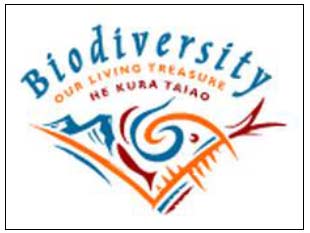
New Zealand’s Biodiversity Strategy acknowledges this country’s global responsibility to help kerb the loss of native biodiversity.
One objective of the strategy has been, through the Marine Protected Areas Policy and Implementation Plan (MPA Policy)8, to protect representative examples of the full range of widespread marine ecosystems in each of this country’s 14 biogeographic regions. At the same time, the strategy urges protection of the ‘outstanding, rare, distinctive or internationally or nationally important’ marine habitats and ecosystems. Our protected areas would be a small koha to the world’s native biodiversity—as well as our contribution toward sustainability of resources for future generations. And, in turn, other nations make their gift to us.
The first split in the MPA Policy’s hierarchy for widespread ecosystems concerns how salty the waters are; the next separates according to depth; then the level of exposure to swells, waves and currents; and finally seafloor type.
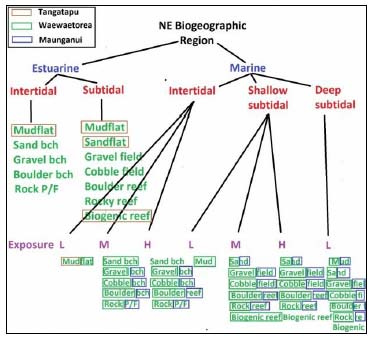
New Zealand Marine Protected Areas Policy’s8 classification to capture representative examples of widespread coastal ecosystems (high water to 200-metres depth) in each biogeographic region. Associated with each cell are bottom-dwelling plants and animals and the immediately adjacent fauna. Shallow subtidal is down to 30 metres—about as far as light penetrates into seawater. Exposure refers to the extent to which a possie is subject to swells, waves, and currents (low to high).
In addition to exposure, all manner of other variables shape marine communities: nutrients, dissolved oxygen, micro-chemicals, bacteria, light levels, and so on. But we’ll settle for just one more: water clarity. Seaweed survives only where there’s sufficient light, and in turn kelp forests shape whole communities.
Blooms of plant plankton, as well as wave-churned waters, are always going to make it difficult to see to the bottom, but the main culprit to dull our view is silt derived from land runoff. Even today, a simple white or black and white disc, held horizontally and lowered into the water until it just disappears from view, is an acceptable measure of relative water-clarity for most purposes. These discs are typically 20 or 30 centimetres across (although the smallest may have been 2 centimetres, used by ecologist Robert Carlson to check the strength of his coffee). Typical Secchi Depths for the Bay of Islands using a 30-centimetre white disc are 2-6 metres in inner parts such as the Kerikeri Inlet, anything from 3 to 10 metres for the middle harbour, and up to 15 metres or more on the open side of the outer islands and near the entrance of the Bay.9 (Secchi Depths are typically 50 metres or so for oceanic waters offshore of New Zealand.10)
Estuaries are partly enclosed coastal bodies where water flowing from the land tussles with that of the ocean and are subject not only to the influx of silt, but also to the effects of tides and waves. Both the water column and the sediment of estuaries are among the most productive habitats on Earth. Yet estuaries are typically home to relatively few animal species of any size, and very few large seaweeds. This is partly because of the limited variety of—and mostly muddy—habitats, but especially the
adaptations necessary for plants and animals to deal with wildly fluctuating salinity and water clarity.
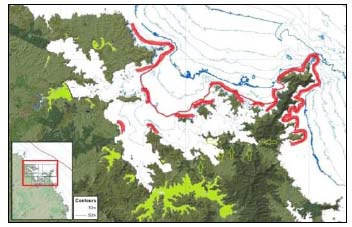
The waters of the Bay of Islands reach 80-metres depth near the entrance, but the main body of the bay is between 30 metres (thin red contour) and 50 metres (inner heavy blue contour) deep. The exposed shores (wide red lines) exist in counterpoint to the relative seclusion of the estuaries (green). The large estuaries lie to the west and south, but there are also estuaries in the east (green arrows).
As we emerge from the confines of estuaries and approach the open sea, the plant and animal life of both the intertidal and subtidal becomes increasingly diverse. Light penetrates deeper into the water; there is increasing variety in habitat-types; increased levels of exposure to waves and swells; and no longer are there the strictures of great changes in saltiness with every tide.
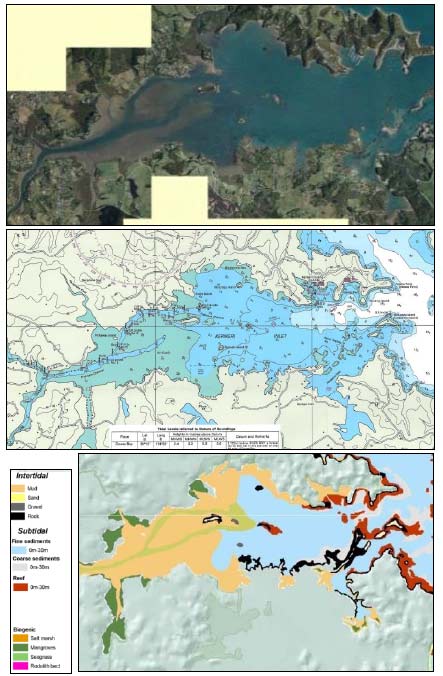
High-resolution aerial photographs (upper, available at http://www.linz.govt.nz/hydro/projects-programmes/oceansurvey-2020) help us interpret the chart (centre) and the habitat map (lower). The Kerikeri Inlet—which can defined as an estuary upstream from Wainui Island—parades a variety of habitat types unmatched in the Bay of Islands. Heavily sedimented shores, with mangroves and saltmarsh, give way downstream to rocky reef, shingle and sand.
Further out into the Bay, degree of exposure and depth become the defining variables. If you’re one that becomes affixed to the seafloor, you must first attach, and then hang on; if you’re mobile, you usually need to avoid heavy surge. But such matters are neither here nor there in waters deeper than about 20 metres, where only the heaviest of swells has any direct effect.
$$$$$$$$$$$$$$$$$$$$$$$$$
In order to advance our appreciation of the marine life of the Bay of Islands we must look first to the studies already reported. Leading up to the turn of the millennium, four particular pieces of research had set the scene for all future consideration of the marine ecosystems of the Bay of Islands.
It was one of those hot, sunny Northland afternoons on Saturday 5 January [1980], when a small flotilla of craft paddled, sailed and motored across to Urupukapuka Island at the start of the annual [University of Auckland’s] Offshore Islands Research Group's trip. The party of twenty consisted of a well-balanced mixture of older Field Club "oldies", younger "oldies" and potential "oldies".11
In this the first, the natural history and archaeology of all islands from Motuarohia in the west to Moturahurahu in the east, and the waters between, were examined. Additional to whatever else a university field trip like this might have spawned over the week on an island with more than the hint of the tropics about it, no fewer than nine papers were published in the group’s Tane.12 The ones most relevant here concerned the fishes, and the animals living on soft-bottoms.
The fish survey recorded 57 species, all typical of sheltered inshore waters of east Northland and so not remarkable.13 When it came to the soft-seabed animals, however, Bruce Hayward and colleagues demonstrated the complexity of marine ecosystems. They distinguished no fewer than eight distinct communities (shown earlier this chapter, and each characterised for convenience by one or more species)14 from dredge-sampling down to 12-metres depth in a 3-square- kilometre area south of Urupukapuka Island. The communities were determined most by sediment grain-size, although degree of exposure to wave action was important too.
The next piece of insightful work, focussed on the sea-life associated with rocky diveable reefs, was undertaken by the Department of Conservation’s Fred Brook and Gerard Carlin during the first half of 1991.5 For the first time, an essentially Bay of Islands-wide approach was to be taken and it culminated in an objective method to rate the ecological conservation values of reef habitats for all of northeast New Zealand.
Based on presence/absence of laminarian (seawrack) and fucalean (true kelp) brown seaweeds, Brook and Carlin identified five zones. First was a shallow mixed-weed zone high on the shore, extending from the intertidal to the immediate subtidal, and typically dominated by seawracks (Carpophyllum spp.). Next was an algal turf and paint zone with sparse kelps—what we call the ‘kina-barren’ zone today. The third band was kelp forest most often dominated by the common kelp Ecklonia radiata. Beyond this was a deep zone with sparse common kelp, and below that no kelp at all.
Brook and Carlin then considered the fishes. They recorded 98 coastal species (which excludes the pelagic oceanics such as marlin and flying fish which come and go seasonally) in 40 families, including 29 subtropical species—which they boiled down to three different communities. Assemblage A fish faunas (very high diversity, with many subtropical species) were present on reefs from Deep Water Cove to Motukokako. Assemblage B fish faunas (high diversity, with one or just a handful of subtropical species) occupied seaward-facing coasts elsewhere in the Bay. Assemblage C fish faunas (moderate diversity, with no subtropical species) occurred on reefs in inlets and bays of the inner Bay of Islands. They found the diversity of coastal fish in the outer southeast Bay to be much the same as at the Poor Knights Islands 50 kilometres to the south, and much greater than any other part of northern New Zealand. This is because the area contains not only widespread warm-temperate species, but also many tropical and subtropical species restricted largely to northeast New Zealand.15
Based on their findings for seaweeds and fish, Brook and Carlin concluded that the main drivers of community structure were exposure and water clarity, which led them to define six ecological habitat-types. And, taking into account rarity, diversity, representativeness and naturalness, they decided that Motukokako, much of the Cape Brett Peninsula, and parts of the Black Rocks were of outstanding conservation value. Some of the reefs on seaward-facing coasts between Deep Water Cove and Okahu Island, northwest of Moturoa Island, and near Cape Wiwiki had high conservation value. So too did some reefs in Te Rawhiti Inlet, on the western side of Urupukapuka Island, and at Te Pahi Islands. The rest were of moderate conservation value.
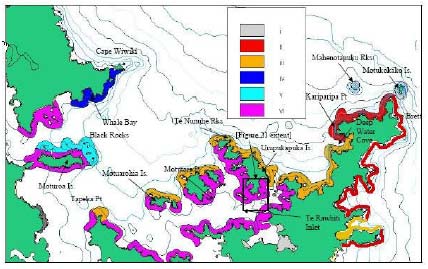
Fred Brook & Gerard Carlin’s ecological habitat types for shallow rocky reefs.
Type i (Exposed, low turbidity)
- Unique, rich algal zonation
- High fish diversity
- Many subtropical species
Type ii (Exposed, low turbidity)
- Rich open-water algae
- High fish diversity
- Many subtropical species
Type iii (Exposed, moderate turbidity)
- Rich shallow to mid-depth, open-water algae
- Moderate fish diversity
- Some subtropical species
Type iv (Exposed, moderate turbidity
- Rich shallow, open-water algae
- Moderate fish diversity
- Few subtropical species
Type v (Moderately exposed, moderate turbidity)
- Variable shallow algae
- Moderate fish diversity
- Very few subtropical species
Type vi (Sheltered, moderate to high turbidity)
- Depauperate algae
- Low fish diversity
- No subtropical species
The third research project, in the mid-1990s, involved molluscs. After dredging down to 60-metres depth at 330 stations, and snorkelling numerous shallow subtidal areas, Margaret Morley and Bruce Hayward of the Auckland Museum Marine Department wrote ‘The Bay of Islands on the east coast of Northland, has the most diverse molluscan fauna of any area of similar size in New Zealand.’ 4 For the 551 molluscs revealed, one third were restricted to the warm waters of the Aupourian (northern) Province.
A fourth area of critical ecological research began before 2000 and continues to be refined to this day. Substrate-mapping (a proxy for the distribution of habitats) of the Northland coast has most recently been spear-headed by Department of Conservation’s Vince Kerr, culminating in 2009 in a set of high-resolution, area-specific maps1 (that for the Bay of Islands being shown earlier this chapter). Requiring precise coordinates, and detailed information on the nature of the seafloor, this work has been pivotal in reaching an understanding around the nature and distribution of the marine ecosystems of the Bay of Islands.
$$$$$$$$$$$$
With these results in hand—together with those from several less-ambitious studies—the National Institute of Water and Atmospheric Research (NIWA) set out onto the waters of the Bay of Islands in the spring of 2009. Using tools electronic (video and still cameras), mechanical (trawls), and animate (divers), they revealed aspects of its marine ecology in detail available for few other coastal seawater bodies of similar size anywhere in the country.
As a marine environment, the Bay of Islands coast is under increasing pressure from competing interests, including aquaculture, fisheries, tourism and recreation. Land-based human activities are also having an impact. The project collected data about Bay of Islands seabed habitats and biodiversity to provide quality baseline data for the future, and a snapshot of the current state of biodiversity.16
Only broad summaries have been produced so far; here is a huge, publicly available baseline data resource that will keep, to be worked up bit by bit and published as time goes by.
The first high-level result came from a towed video that recorded life at night across the whole gambit of seafloor types in waters 10-50 metres deep.17 Twenty-four hours of video, and 5700 still images, were analysed for benthic invertebrates, fish, algae and seabed type. Altogether, 166 different invertebrates, 78 fish, and more than 23 000 individual organisms were recorded. Species present in the northwest were very different to those in the southeast of the Bay, possibly reflecting differences in water clarity. Overall diversity was greatest where the seafloor was mainly rock, most of which is found towards the entrance of the bay. Invertebrate diversity increased with greater exposure and with depth; greatest algal diversity was at 10-12 metres depth in the east and southeast Bay.
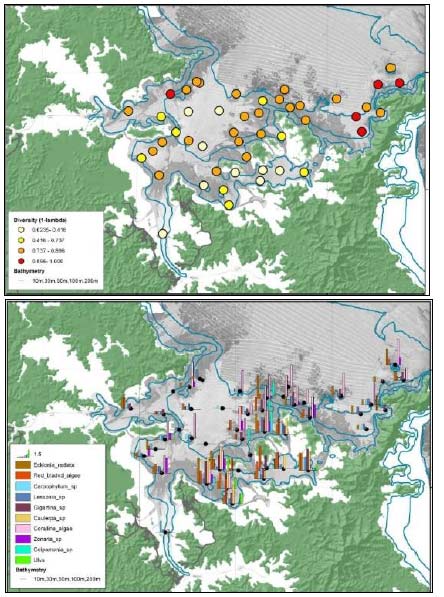
From the towed video, index of benthic-invertebrate diversity (upper), the rosier the colour the greater the number of species present; and the benthic algae (lower), the darker the background tone, the harder the substrate (a bar twice the height of another represents ten times greater abundance).17
More intensive investigations into shallow (to 45 metres) rocky reefs were made using drop cameras/videos and scuba diving.18 The most powerful driver of fish-community species representation and diversity was the location of sites along the gradient from inner to outer Bay, inner sites having low diversity. Depth too was an important determinant, and the level of shelter at a site also interacted with this gradient. For the benthic invertebrate and algal communities of these shallow rocky reefs, depth appeared to be the most important determinant of community structure, although there were obvious trends from inner to outer Bay sites too. And when the fish and benthic data were grouped, the gradient from inner to outer Bay stood out as a common and important factor—the greater diversity in the outer Bay probably coming about through higher water clarity/lower sediment loads, greater wave exposure, and possibly closer proximity to larval sources.
Intertidal life on shallow soft shores was moulded mostly by the level of exposure to waves and currents and the type of sediment. In contrast, biotic features that didn’t correspond particularly closely with the hydrodynamics defined communities subtidally. Examples were the biogenic reefs, and the surprisingly extensive areas of algae that restricted the more-usual beds of suspension-feeders.19
For the intertidal seaweeds, exposed shores were home to many more species than sheltered ones.6 The subtidal rocky reefs were the next most diverse, but an unexpected 40 species were found associated with soft sediments, six not being found anywhere else.
In the deep subtidal areas (30-200 metres), while depth and habitat type were influential, location along the gradient from inner to outer Bay was the most important factor influencing fish-community structure and species diversity.20 Conspicuous attached-life on reefs at these depths comprised detritus-feeding and plankton-filtering invertebrates dominated by sponges, hydroids and corals. The most common fish were pink maomao (Caprodon longimanus), butterfly perch (Caesioperca lepidoptera) and various scorpionfishes. In soft areas, silver conger eels (Gnathophis habenatus) and red bandfish (Cepola aotea) were abundant, the first time for these species to be recognised as significant components of a seafloor fish assemblage. However, most of the action was out of sight beneath the surface of this otherwise rather barren landscape, in the form of worms, molluscs and burrowing crustacea.
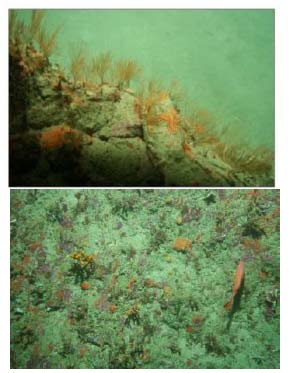
On deep reefs, colourful sponges amidst hydroids and corals have replaced seaweeds.17
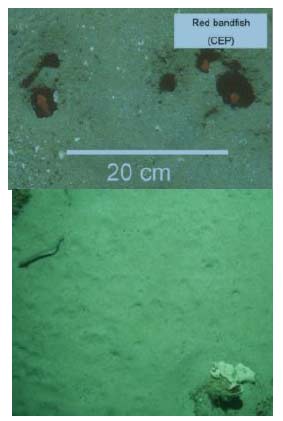
Red bandfish (upper) and silver conger eels (lower) were surprisingly common on the largely featureless soft seafloor of deep waters. Red bandfish are eel-like fish that burrow and so are rarely encountered—except in snapper guts.20
$$$$$$$$$$$$$$$$$$$
Useful as it may be, it’s immediately obvious that this essentially two-dimensional categorisation of life on the seabed and just above simply doesn’t cut the mustard. There is nary a word about the ensemble of plankton, pelagic fishes, seals and cetaceans (whales and dolphins) in the waters above. And looking down on them, the seabirds. This is like ignoring the swarms of starlings paravaning above as you contemplate threats to the crops on the lower forty-nine.
It’s hard to ignore the teeming sealife frequently encountered around such islets as Motukokako and near-surface rock pinnacles like Whale Rock. Secondary flows developing in the curving current around such places lead to upwelling of nutrient- and plankton-laden water, often with astonishing aftermath.21 You may become surrounded by acre upon acre of trevally (Pseudocaranx dentex), maomao (mainly blue [Scorpis violaceus] but sometimes pinks too), kahawai (Arripis trutta), especially parore (Girella tricuspidata), their heads just out of the water to feed on small sealife at the very surface. There are subtle sucking sounds—until the school is spooked into explosive frothing by a shadow above or some threat below.
And then - the action really begins.
Perhaps the most exciting spectacle for sea explorers both on the surface and beneath, is the melee of feeding fish and birds—thrashing, wheeling, foaming the water as predator dives and rushes at prey. This activity can be seen anywhere in the Bay but the size and intensity of the encounter is usually greatest adjacent to isolated rocks, islets, or headlands such as Whale Rock, Bird Rock, Cape Brett or Piercy Island and the water between them. It all begins when school fish, usually kahawai or trevally, but occasionally mackerel or tuna, seek out and force the prey—small fish, larval fish, or one of several types of planktonic crustacean, often shrimp-like krill—against the sea surface. Birds, either gulls or terns with fish, or petrels with krill, sight the impending feast from afar and flock to the scene. The prey have little hope of escape. Feeding fronts develop at random and often in several directions simultaneously. The petrels are the most successful aerial hunters, especially the diving petrels. They can be seen head down, bottom up, watching, waiting, then disappearing on a long underwater chase. Terns dip and flick uttering brief high pitched squeaks. Gulls hover, wheel and scream. Larger petrels silent, rush with outspread wings and feet like skis skilfully controlling direction and speed. Gannets may join the fray, spiralling up, cruising, searching, and plunging spear-like with minute corrections of folded wings.22 Below, the pace increases as the activity attracts an ever widening variety of fish species. Roving bands of kingfish join the hunt often preying on the small predators such as jack mackerel [Trachurus declivus] and kahawai. Electric streaks of foam denote passage of a large predator, a big kingfish, mako shark or marlin. Snapper rush at scraps and wounded prey which manage to leave the surface. Below these again one or more bronze whaler sharks may appear to twist and rush at prey and predator alike. As the prey becomes depleted or dispersed and both aerial and subsurface hunters reach saturation the frenzy subsides. Fish schools sink from view. Birds rest and preen on the sea's surface amidst an expanding slick of oil released from dismembered prey. Others fly low and heavily back to roost on islands, rocks or shores. Peace returns.22
A further shortcoming of the New Zealand Marine Protected Areas Policy classification is that it tends to oversimplify complex ecologies. For example, shallow subtidal sand bottoms can, depending on the physical environment, support entirely different communities in one place compared with another. For the eastern Bay of Islands, where there is a great variety of habitats across a small distance, the sand seafloors are home to a variety of invertebrates and algae not found on sand anywhere else in the Bay in such profusion. These include the biogenic reefs and scallop grounds, examined in more detail shortly.
$$$$$$$$$$$$$$$$$$
New Zealand’s MPA Policy is also concerned with ecosystems that are outstanding, rare, distinctive. In the Bay of Islands these include huge salt marshes, great mangrove forests, luxuriant subtidal seagrass meadows, and extensive areas of biogenic reef. Zeniths of biological complexity surround the capes that define the Bay. Strange geological formations direct the sealife that thrives among them.
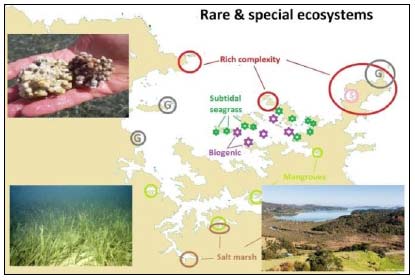
Some of the Bay’s rare and special ecosystems. G, geological features: the Black Rocks, Brampton Reef and Cape Brett/Motukokako.
The choicest of the Bay of Islands’ mangrove forests are associated with stream mouths. The Tangatapu Mangrove Estuary at the head of Parekura Bay links a wetland/floodplain under restoration with an expansive sand-flat delta teeming with invertebrates.
A quiet day, and an opportunity to check out a place that looks like it should be crocodile-country. The tide’s in, and we’re right up at the Tangatapu road bridge where the more-dense saltwater forms a wedge beneath the freshwater draining from Tane Mahuta’s whenua above. Precious remnants of an ancient marsh forest guard both sides of the channel, shortly to be re-united through community endeavour with a revitalised Jurassic podocarp forest that was the original inhabitant of this flood plain. A little below the bridge are saltmarsh fields—patches of oioi rush [Apodasmia similis] taking turns to yield to the breeze, flashing their own fields of gold, with pretty little areas nearby of saltmeadow containing succulent herbfields.
Launching our waka-iti, as hundreds have done in days gone by, we paddle slowly down the sinuous channel between increasingly larger mangroves of the manawa forest; ah! manawa also means the human heart!
There’s not the variety of fishes to be seen in these rather turbid waters: tight schools of yellow-eyed mullet [Aldrichetta forsteri], larger individual grey mullet [Mugil cephalus] as part of much-more diffuse groups, and the seemingly ubiquitous parore too. But in season, whitebait—and even elvers of our precious long-finned eel [Anguilla dieffenbachii]—head in an opposite direction to us. Much of the biodiversity here—at least of that which stands out to the casual eye—lies in the heart of the manawa forest. The trees themselves largely direct things, their radiating networks of breathing roots slowing currents and allowing silt to settle here rather than smothering more open parts of the Bay—and at the same time creating and depositing great amounts of organic material. Three types of shag, herons, kingfishers [Halcyon sancta vagans] and other shore birds rest and roost in branches, some of which are well over a hundred years young; other birds like banded rails [Rallus philippensis] and spotless crakes [Porzana tabuensis plumbea] romp beneath the trees once the tide has receded.
At low water this channel into the heart of the mangrove forest is land-locked, its incumbents compelled to wait for the new tide to freshen things up. But the dozens of hectares of sand flat now revealed are abuzz. The great variety of small invertebrates and even fishes available—some revealed via a stout beak just made for the job—are morsels of choice for the grey-faced herons [Ardea novaehollandiae novaehollandiae], plovers [Vanellus miles novaehollandiae], variable oyster catchers, New Zealand dotterels [Charadrius obscurus, with a global count of perhaps 1700], and even the gulls.
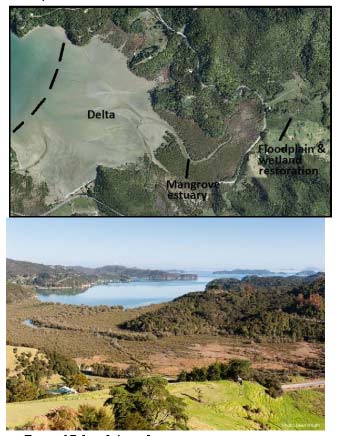
Bay of Islands’ corker mangrove estuary at Tangatapu, at the head of Parekura Bay (Photo: Dean Wright). The almost kilometre-long tidal channel allows high-water small-boat access right through to the freshwater source near the road. At low tide a vast sandflat delta is revealed, eagerly worked over by shorebirds. This is the site of a suggested scientific reserve (http://www.fishforever.org.nz/).
$$$$$$$$$$$$$$
The subtidal seagrass (Zostera muelleri) beds of Kaimarama, Hauai, and Kaingahoa bays are among the few significant ones associated with mainland New Zealand.23 The only other noteworthy areas of seagrass in the Bay of Islands—also subtidal—fringe sweet little bays on the islands of Ipipiri where neatly they provide the black velvet band separating idyllic bush-fringed beaches from the clear waters of the coarse-sand seafloor deeper down.
One of the top-notch seagrass meadows has to be the lush one at Otiao Bay. This meadow seems to have flourished for most of, if not all, the past 70 years at least—unlike the more patchy performance of others within cooey and in spite of hundreds of anchor-drags each year. And this particular field is unique in that it is linked almost seamlessly to a pretty little mangrove estuary—the only one on an island in this part of the world.
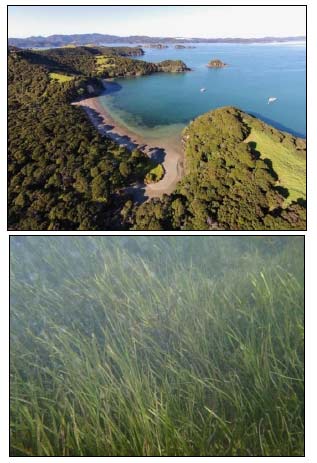
The subtidal seagrass meadow at Otiao Bay on Urupukapuka Bay is separated by beach from what may be the Bay of Islands’ tiniest mangrove estuary (upper; Photo Dean Wright). The seagrass grows with determination, despite everything we throw at it (lower).
$$$$$$$$$$$$$$$
Brutal beauty; the feeling of some overpowering presence and wild foreboding; broody upwelling of deep dark waters that reveal a marlin; on the fringe, caution exacted. Yet you are momentarily rendered careless, entranced. This is perhaps how Motukokako, off Cape Brett, affects you.
This cape is a well-known landmark to vessels entering the port, and, as the whole breadth of the Pacific washes up against its rocky sides and rebounds with a deep, sullen roar, there is always in the neighbourhood a dangerous sea rolling….24
Not one of its individual marine habitats is uncommon; it’s more the way they’re assembled and presented to us that makes this marine ecosystem world-class to the specialist ecologist and the casual diver alike. Erupting 250 metres from the seafloor to its 150-metre-high summit, Motukokako’s face to the world is an opening through which small ships pass. But there’s much more to this motu. The practically vertical walls mean that some zonations of life-form are compressed because there is no horizontal plane to speak of, while others have been expanded because of the way waves dash up the sides of the island. At low water under a gentle swell, vertical lines of seawrack hang taut—dripping—as the water retreats, and then yield and extend as great lank fingers as it returns. Below, the zonation sequences are different to any other part of the Bay of Islands.5 Most noticeable is the 8-metres depth to which the shallow-mixed-weed zone extends, and below that the substitution of the algal-turf-and-paint kelp-forest with deep-kelp zones and a colourful patchwork of filter- and detrital-feeders. Cathedral Cove’s hole-in-the-rock-in-the-making provides darkness for fishes that normally live deeper. These include golden snapper Centroberyx affinis, fish with golden-orange glow brighter than any sunrise. Around this island and nearby can be found almost every one of the fish ever recorded for the Bay of Islands—including most of the warm-water itinerants.
A mako rockets by.
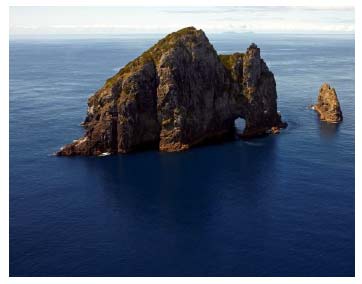
Off Cape Brett (Cap Quarrie if the French name had stuck) is Motukokako (Piercy Island), much smaller Te Tiheru guarding its western flank (Photo: Salt Air). The dark fold in Motukokako left of the Hole in the Rock is Cathedral Cove, its darkness promoting life-forms not found in sunlit areas. Missionary William Colenso reported there had been a pa on the top of Motukokako.
$$$$$$$$$$$$$$
In contrast, Okahu Channel, separating Okahu (or Redhead, because of the hue of its weathered-greywacke crown) and Waewaetorea islands, is everyone’s dream of tranquillity. It lies plumb in the midst of the proposed Waewaetorea Marine Reserve (http://www.fishforever.org.nz/), a place where we can gather a sense of much of both the widespread and rare ecosystems using only a snorkel.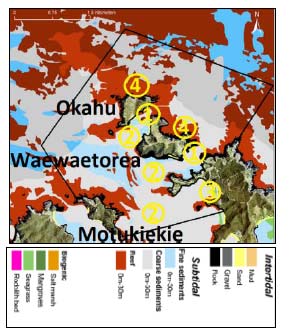
Snorkelling reveals a rich assortment of marine ecosystems in the proposed Waewaetorea Marine Reserve. Numbering informs the text.
On the seaward margins of the islands and dividing channels, the visibility is sometimes more than 15 metres. Patrolling the exposed outer faces and headlands in summer are schools of kahawai and sometimes fast moving packs of large kingfish [Seriola lalandi]. Dense swathes of seaweed festoon the rock faces, but in some places there are ghostly pale surfaces where kina [Evechinus chloroticus] have cropped the growth. Occasionally, in gaps between boulders the long, slender black spines of Centrostephanus rodgersii sea urchins radiate from their small dark round bodies. Great clefts into mother rock are almost devoid of light, so this is where filtering invertebrates predominate, often walls of jewel anemones [Corynactis australis] and yellow zooanthids. A dark crevice may be defended by the parrying feelers of half a dozen smallish red crayfish [Jasus edwardsii], and deeper, where the reef meets the sand, a yellow moray eel [Gymnothorax prasinus] faces off with attitude. (1 in map above.)
The outgoing tide in the outer channels brings blue maomao, sweep [Scorpis lineolatus] and sometimes heaps of little snapper up into the column to scavenge. A hiwihiwi [Chironemus marmoratus] lies still on the bottom ready to woof. Pelagics hang about on the edge of visibility: koheru [Decapterus koheru], kahawai, sometimes trevally, occasionally schools of small tuna. A swarm of tiny squid flow back and forth with the surge. On the sand bottom further into the channel, an eagle ray [Myliobatis tenuicaudatus] has worked sand up over each wingtip for camouflage. Deeper down are great beds of morning star clams [Tawera spissa], their shells-zigzagged in an infinite variety of patterns-just visible. There are also small patch-reefs inside these sheltered channels. You can sometimes find rare treasures such as the painted moki [Cheilodactylus ephippium] and giant wandering anemone [Phlyctenactis tuberculosa] amongst these reefs. (1 in map above.)
The extensive biogenic seafloor flats that link Waewaetorea and Urupukapuka islands with Motukiekie are largely made up of the remains of animals that used to live there, and in the water above. This is scallop [Pecten novaezelandiae] and dog-cockle [Tucetona laticostata] country, and also where you encounter the lairs of octopus [Pinnoctopus cordiformis] surrounded by shells. The patchy cover includes coralline turfs, rhodoliths (red algae that live in a calcareous commune) and vivid green miniatures of a forest-tree which interrupt the otherwise light-coloured palette of the seafloor the seaweed rimurimu [Caulerpa]. (2)
The luxuriant seagrass meadows of Otiao Bay, where boaties seek a night without rock 'n roll, are a nursery for piper [Hyporhamphus ihi], snapper [Pagrus auratus] and trevally. (3)
On the seaward sides, life on the upper reef faces is built for resilience, but as we drop below 15 metres we’re essentially beyond the main zone of turbulence, and more fragile filter-feeders are able to hang on. Here, where the light is getting dim, we’re beyond the kina. Encrusting sponges, seaquirts, anemones, tubeworms, moss plants (bryozoans) and gorgonian sea fans have replaced the seaweeds. (4)
At anchor at night, a strange jellyfish floats by: attached to its bell is a strange transparent leggy animal-the larval stage of a slipper lobster. This serves to remind us how close we are to the blue water and the really deep ocean, with its host of seldom-encountered treasures.
Being transitional between barren sand and rocky reef, the three-dimensional relief of the biogenic seafloors in this otherwise rather featureless backdrop provides a host of animals and plants with settlement places and refuges from predation2—hence the label ‘ecosystem engineer’. Prominent here are rhodoliths—long-lived, slow-growing communal red algae that are particularly prone to ocean acidification, rising sea temperatures, changes in water clarity and quality, and to dredging and trawling.25
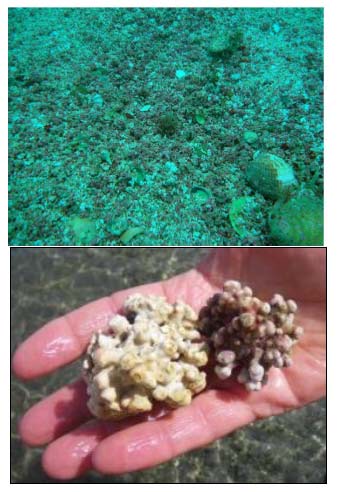
Rhodoliths cause soft seafloors to resemble hard ones (upper). Spirolithon durum (the white one bleached as you might stumble upon on a beach) are common in the Bay of Islands and may be decades old.6, 25
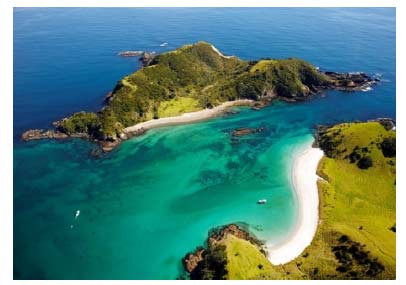
Okahu Channel, where cerulean merges seamlessly into azure, then turquoise (Photo: Salt Air).
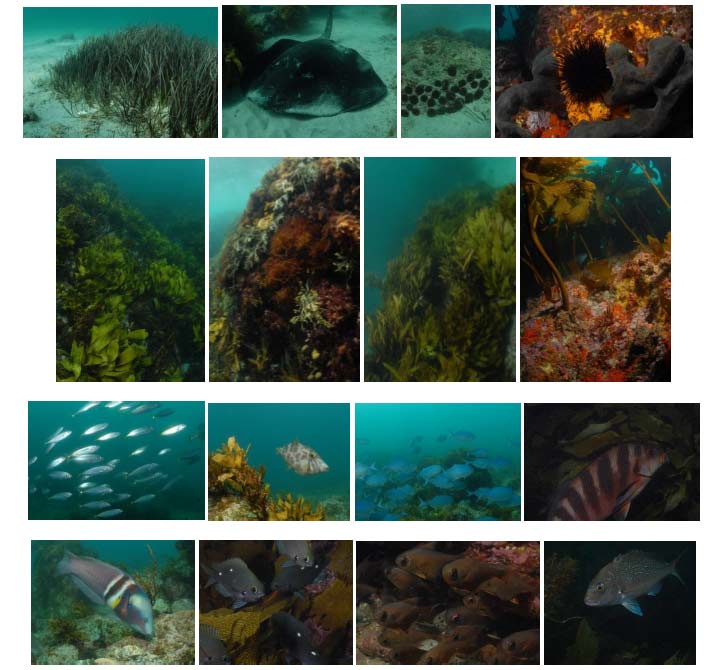
Plants and animals of the channels (1 in the habitat map above). Tufts of seagrass contrast with white sands (A); eagle ray Myliobatis tenuicaudatus (B); kina barren (C); and black sea urchin Centrostephanus rodgersii (D). Multi-fronded kelp Lessonia variegata (E), tufting reds (F), and Carpophlum (G) in shallow waters yield to common kelp Eklonia (H) deeper down. Koheru Decapterus koheru (I); leatherjacket Parika scaber (J); blue maomao Scorpis violaceus (K); and red moki Cheilodactylus spectabilis (L). Sandager’s wrasse Coris sandageri (M); two-spot demoiselle Chromis dispilus (N); big-eye Pempheris adspersus (O); and snapper Pagrus auratus (P). (Photos: Roger Grace)
$$$$$$$$$$$$$
To Governor Robert Fitzroy the Black Rocks resembled the remains of some giant mole.26 But his was a temperament prone to depression (culminating in 1865 when ‘he rose from his bed, bolted the door to his dressing room and slit his throat with a razor’), so any account of his regarding the origins of these impressive castle-rocks near the entrance to the Kerikeri Inlet might be taken with a pinch of salt. Charles Dickens—although of course primarily a novelist—would surely be more dependable. ‘From the Black Rocks, on Friday’ is an apparently truthful record of an English clergyman, who, in August 1859, was blown clear away from the Black Rocks to end up at Sunday (now Raoul) Island in the Kermadec group.24
However, this little-acknowledged ‘Dickens’ account is also not without its snags, for it seems that his Black Rocks lay six miles east of Cape Brett and were always visible above the sea surface. No such rocks exist there today, nor did they within five years of the ecclesiastic’s misadventure according to 1864’s The New Zealand Pilot.
‘Off the northern and eastern ends of Motu-Roa lie the Black Rocks, so called from their colour; they are a remarkable group of smooth, flat-topped rocks, about 15 feet high, steep, and with no dangers about them’.
These columnar basaltic lava-flow remnants have steep-sided subtidal reefs extending down to 30 metres, interspersed with caves, tunnels, shafts and very large boulders.5 The near-vertical faces may appear at first glance similar to those of Motukokako, but many of the incumbents are very different. For example on the exposed faces of the Black Rocks, a dense band of small to medium-sized green-lipped mussels (Perna canaliculus) predominates intertidally, with larger, heavily fouled ones deeper down. Juvenile packhorse rock lobsters Sagmariasus verreauxi live in unusually high quantities among the rock rubble and crevices deeper down.
The great mole’s remains are for now anyway celebrated in the flagship wine of Marsden Estate’s Black Rocks Chardonnay. ‘A mouth-filling body yet smooth.’ I agree.
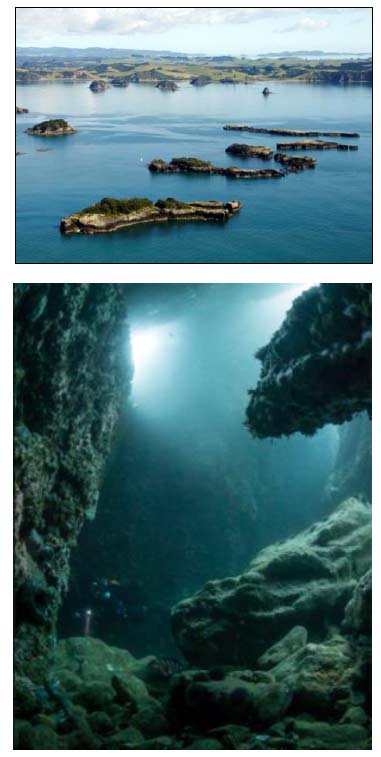
The northern scatter of the Black Rocks, with Te Pahi Islands in the near distance (upper, Photo: Salt Air). Massive caverns are rendered eerie through poor algal cover, presumably for lack of light, but also kina grazing in the sunlit waters (lower (Photo: Paihia Dive). I have not been able to pinpoint Maori names for any of the Black Rocks.
$$$$$$$$$$$$$
The manner in which the Cape Brett Peninsula pokes out into the southward flow of the East Auckland Current—as a finger raised to a disputatious child—results in subtropical water being directed into the Bay of the Islands. We see this not only in the seasonal arrivals close to shore of flying fish, bluefish and sunfish, skipjack and marlin, but also in the year-round presence of subtropical fishes along the inner shore of the peninsula, many of which are seldom seen elsewhere in the Bay. And set within the inner shore of Cape Brett Peninsula is Maunganui Bay, the centrepiece of the second proposed no-take marine reserve for the Bay of Islands (http://www.fishforever.org.nz/).
In the early 1990s Fred Brook and Gerard Carlin estimated there to be 29 tropical and subtropical fishes living year-round along the Cape Brett Peninsula, several presumably breeding there.5 A decade later, NIWA’s Malcolm Francis with colleagues added nine new records for the Bay of Islands, two-thirds from the Cape Brett Peninsula with half of them from Deep Water Cove itself.27 The warm summers-autumns of 1996, 1998 and 1999 were hum-dingers for tropical and subtropical fish in the Bay of Islands (and the Poor Knights Islands). Although their populations are probably maintained by recruitment from Norfolk Island and further afield, rather than through local spawning, many appear to survive the Northland winters.27,28
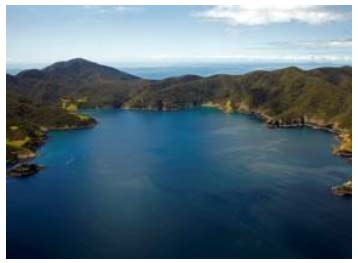
Maunganui Bay (Deep Water Cove in the upper left corner) is presently under a temporary rahui, which prohibits all fishing apart from for kina (Photo: Salt Air).
Here’s a delightful juxtaposition of the tumultuous and the tender.
In the nook of Deep Water Cove, a boatie finds protection from almost any weather. So too do many subtropical creatures that seldom make an appearance anywhere else in Aotearoa. You’ll find, too, one of the great hikoiists of the world, the highly migratory packhorse cray, just taking a breather.
And sitting plumb in the middle of the bay is the frigate Canterbury. Nature herself provides few handrails to be illuminated with exquisite jewelledanemones; or extensive vertical surfaces to be colonised by filter-feeding animals; or room-shaped caverns that suit even the shiest of fishes. Never far away, eternally attracted to an artificial reef like this, are circling mackerel [Trachurus declivus], koheru, kahawai and kingfish—and dense schools of plankton-feeding butterfly perch.
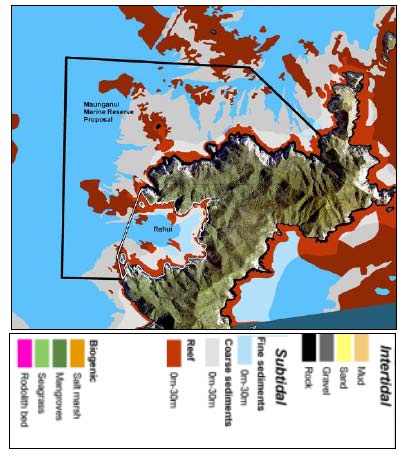
Habitat map for the proposed Maunganui Marine Reserve.
Yet most of the Maunganui Reserve is fully exposed to the might of the Pacific, the land’s defences being majestic vertical cliffs plummeting to the great depths, just a rock ledge near high water dividing the two worlds. Near the entrance we see a male-pair of giant boarfish [Paristiopterus labiosus], approaching a metre in length, followed immediately by colourful triple fins merely a couple of centimetres long.
Deep gashes in the rock form twisting canyons, dense kelp surging back and forth in the shallows, the shaded arches studded with jewelled-anemones and kowhai-yellow sponges. A giant crimson scorpionfish [Scorpaena papillosus] waits to wolf-in whatever wildlife gets too close to its cavernous oral aperture.
$$$$$$$$
The Bay of Islands – its waters extending from intricate tributaries trickling into a mangrove estuary out to great rock bastions that defend the place from ocean swells, at the same time being destroyed by them rock by rock – is a treasure trove of life form and ecosystem complexity. Our enquiry into this rich arras has taken us on journeys both over and under the sea, but at scales no finer than hundreds of metres; zeroing in further is for the generations who follow.
In the meantime, establishing protection from human harm representative examples of healthy functioning widespread ecosystems, and those rare and special, has never been more urgent. And this story closes with the chart of ecosystem types shown earlier, but with the ones represented in the proposed two marine reserves, and one scientific reserve, highlighted.

Just how well do our three candidate sites capture representative habitats under the New Zealand Biodiversity Strategy coastal classification scheme? The boxed classes represent habitats present in Tangatapu, Waewaetorea and Maunganui Bay.
Acknowledgements
My thanks to Chris Richmond and Jeremy Gibb for helpful reviews of this essay, and to Salt Air, Paihia Dive and Roger Grace for use of their stunning images.
References
- Kerr, V. (2009). Marine habitat map of Northland: Mangawhai to Ahipara. Version 1. Department of Conservation, Whangarei.
- MacDiarmid, A. plus 26 others (2009). Ocean Survey 20/20. Bay of Islands Coastal Project. Phase 1 – Desk top study. NIWA Project LIN09302.
- Cometti, R.; Morton, J. (1985). Margins of the sea. Hodder and Stoughton.
- Morley, M.S.; Hayward, B.W. (1999). Inner shelf Mollusca of the Bay of Islands, New Zealand, and their depth distribution. Records of the Auckland Museum 36: 119-138.
- Brook, F.J.; Carlin, G.L.F. (1992). Subtidal benthic zonation sequences and fish faunas of rocky reefs in Bay of Islands, northern New Zealand. Department of Conservation, Northland Conservancy.
- Nelson, W.; D’Archino, R. (2010). Bay of Islands OS20/20 survey report. Chapter 12: Attached benthic macroalgae. http://www.linz.govt.nz/hydro/projects-programmes/ocean-survey-2020
- The New Zealand Biodiversity Strategy (2000). https://www.mfe.govt.nz/publications/biodiversity/nz-biodiversity-strategy-feb00.html
- Department of Conservation (2005). Marine Protected Areas Policy and Implementation Plan.
- Booth, J.D. (1974). Observations on the hydrology of Bay of Islands, New Zealand. New Zealand Journal of Marine and Freshwater Research 8: 671689.
- Doron, M. plus four others (2011). Ocean transparency from space: Validation of algorithms estimating Secchi depth using MERIS, MODIS and SeaWiFS data. Remote Sensing of Environment 115: 2986–3001.
- Hayward, B.W. (1980). Offshore Islands Research Group trip to the eastern Bay of Islands, January 1980. Tane 26: 107-113.
- McCallum, J. (1983). A review of field research on the northern offshore islands. Tane 29: 223-233.
- Nicholson, J.; Roberts, L.I.N. (1980). A survey of marine fishes of Urupukapuka Island, Bay of Islands, New Zealand. Tane 26: 135-143.
- Hayward, B.W.; Grace, R.V.; Brook, F.J. (1981). Soft-bottom benthic macrofaunal communities of the eastern Bay of Islands, northern New Zealand. Tane 27: 103-122.
- Oc20/20 Desktop: 250. http://www.linz.govt.nz/about-linz/what-were-doing/projects/ocean-survey-2020
- http://www.linz.govt.nz/hydro/projects-programmes/ocean-survey-2020/work-programme/bay-of-islands
- Bowden, D. plus four others (2010). Bay of Islands OS20/20 survey report. Chapter 9: Seafloor assemblage and habitat assessment using DTIS. http://www.linz.govt.nz/hydro/projects-programmes/ocean-survey-2020
- Parsons, D. plus six others (2010). Bay of Islands OS20/20 survey report. Chapter 10: Shallow rocky reefs. http://www.linz.govt.nz/hydro/projects-programmes/ocean-survey-2020
- Hewitt, J.; Chiaroni, L.; Hailes, S. (2010). Bay of Islands OS20/20 survey report. Chapter 11: Soft-sediment habitats and communities. http://www.linz.govt.nz/hydro/projects-programmes/ocean-survey-2020
- Jones, E. plus five others (2010). Bay of Islands OS20/20 survey report. Chapter 13: Fish communities. http://www.linz.govt.nz/hydro/projects-programmes/ocean-survey-2020
- Russell, P.; Vennell, R. (2009). Observations of secondary flow and upwelling at Cape Saunders, Otago Peninsula. In Coasts and Ports 2009: In a dynamic environment. Engineers Australia, Wellington.
- Department of Conservation (1984). Bay of Islands Maritime and Historic Park.
- Rowden, A.A. plus 10 others (2012). A review of the marine soft-sediment assemblages of New Zealand. New Zealand Aquatic Environment and Biodiversity Report 96.
- Reed, A.H. (1950). From the Black Rocks, on Friday and A gold digger’s notes edited (or written?) by Charles Dickens. A.H. and A.W. Reed, Wellington.
- Nelson, W.A. plus six others (2012). Rhodolith beds in northern New Zealand: characterisation of associated biodiversity and vulnerability to environmental stressors. New Zealand Aquatic Environment and Biodiversity Report 99.
- Keynes, R. D. ed. (2001). Charles Darwin's Beagle diary. Cambridge University Press.
- Francis, M.P.; Worthington, C.J.; Saul, P.; Clements, K.D. (1999). New and rare tropical and subtropical fishes from northern New Zealand. New Zealand Journal of Marine and Freshwater Research 33: 571-586.
- Francis, M.P.; Evans, J. (1992). Immigration of subtropical and tropical animals into north-eastern New Zealand. In Battershill, C.N. et al (eds) ‘Proceedings of the Second International Temperate Reef Symposium, 7-10 January 1992, Auckland, New Zealand. Pp 131-136.
- Cook, S. de C. Ed. (2010). New Zealand coastal marine invertebrates. Canterbury University Press.
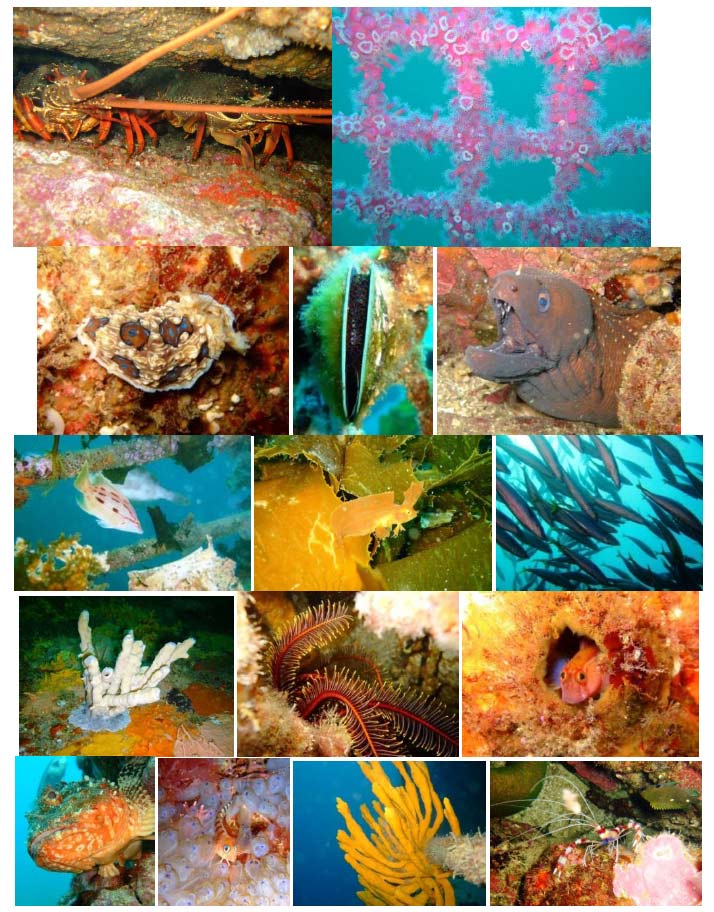
Prolific and varied sealife in Maunganui Bay, including on the scuttled frigate Canterbury. Packhorse rock lobster Sagmariasus verreauxi (A) and jewel anemones Corynactis australis (B). Nudibranch Dendrodoris denisoni (C); green-lipped mussel Perna canaliculus (D); and mottled moray Gymnothorax prionodon (D). Red pigfish Bodianus vulpinus (E); Crested weedfish Cristiceps aurantiacus (F); and Jack mackerel Trachurus declivus (G). Organ-pipe sponge Callyspongia latituba (H); feather star Cenolia spanoschistum (I); and crested blenny Parablennius laticlavius (J). Northern scorpionfish Scorpaena cardinalis (K); blue-eyed triple fin Notoclinops segmentatus and acidean Clavelina sp. (L); Axinella sp. sponge (M); and banded coral shrimp Stenopus hispidus (N). (Photos: Paihia Dive).
